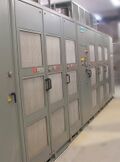Basics:Difference Between A Soft Starter and A Variable Speed Drive
Soft starters and variable speed drives[1] can both be used to reduce inrush current and limit torque thereby reducing large electrical and mechanical stresses on the motor windings, cables and components and can extend the life of a motor by reducing the amount of heat caused by frequent start and stops.
What’s a soft starter?
Solid state soft starters use semiconductor devices to temporarily reduce the motor terminal voltage. This provides control of the motor current to reduce inrush and limit shaft torque. As the name suggests, soft starters allow the motor to start the load more gradually by limiting the voltage to the motor and providing a reduced torque.
In addition to reducing energy consumption, a reduced voltage soft starter helps protect the motor and connected equipment from damage by controlling the terminal voltage.
This limits the initial inrush of electrical current and reduces the mechanical shock associated with motor start up. By gradually increasing the motor terminal voltage the soft starter produces a more regulated motor acceleration up to full speed. Soft starters are also capable of providing a gradual ramp to stop, where a sudden halt may create problems in the connected equipment.
What’s a VSD / VFD?
As the name suggests, a VSD is a control device that varies the operating speed of a motor. A VSD, sometimes simply called a drive, inverter or variable frequency drive (VFD), can control the speed of the motor during the start and stop cycle, as well as throughout the run cycle.
VSDs convert constant frequency and voltage input power to adjustable frequency and voltage source for controlling the speed of AC induction motors. VSDs allow for controlled starting, stopping and acceleration, as well as dynamic torque control during a motor’s operation.
Which to choose?
Choosing a soft starter or VSD completely depends on your application. Soft starters are smaller and less expensive when compared with VSDs, especially in larger horsepower applications. Larger VSDs take up more space and are usually more expensive than soft starters. However, while VSDs can be more expensive initially, they can provide significant energy savings, therefore providing operating cost savings over the life of the equipment for a lower total cost of ownership.
Speed control is another advantage of a VSD, because they offer consistent acceleration time throughout the entire operating range of the motor, not just during start up. VSDs can also provide more flexible functionality than soft starters offer, including digital diagnostic information.
In most cases, VSDs deliver considerable energy savings. For example, using a VSD to slow a fan or pump motor from 100 percent to 80 percent can save up to 50 percent of the energy used. Controlling the speed of a motor reduces energy usage during the highest energy-consuming points, the start-up cycle, which requires extreme acceleration to power it at full speed.
VSDs not only help reduce consumption during start-up but also give manufacturers total control of engine speed in all phases of the motor, which reduces stress on the system, helping devices to last longer.
That said, it’s important to note that VSDs can initially cost two to three times more than a soft starter. Therefore, if constant acceleration and torque control is not necessary, and your application only requires current limiting during start up, a soft starter may be a more cost-effective solution.
Variable Speed Drives are extremely versatile and are often used in process applications where a constant pressure or flow needs to be maintained. In addition, because the motor can be run at a slower speed and hence use less energy (cube law), VSD’s can save a lot of energy and money. They are good at reducing peak energy demand or reducing power when not required.
Variable Speed Drives offer fully adjustable speed (pumps, conveyors, and fans) and can control starting, stopping, and acceleration. The speed control that an inverter offers can be used to reduce the pressure surges caused in piping systems.
